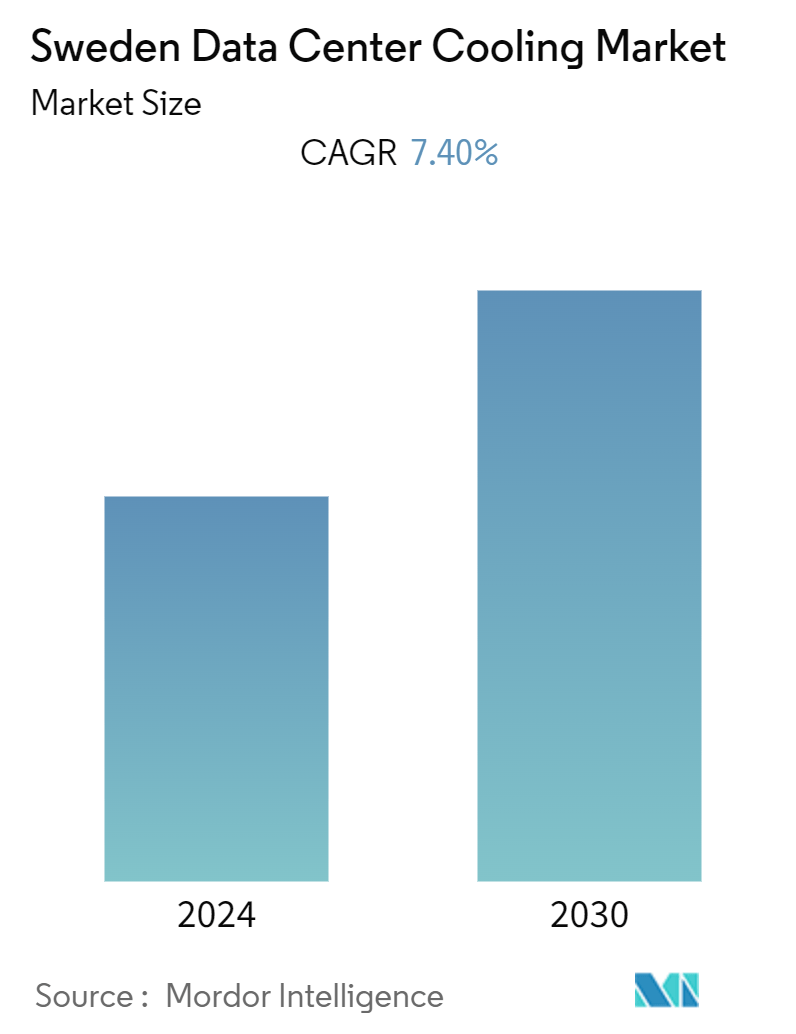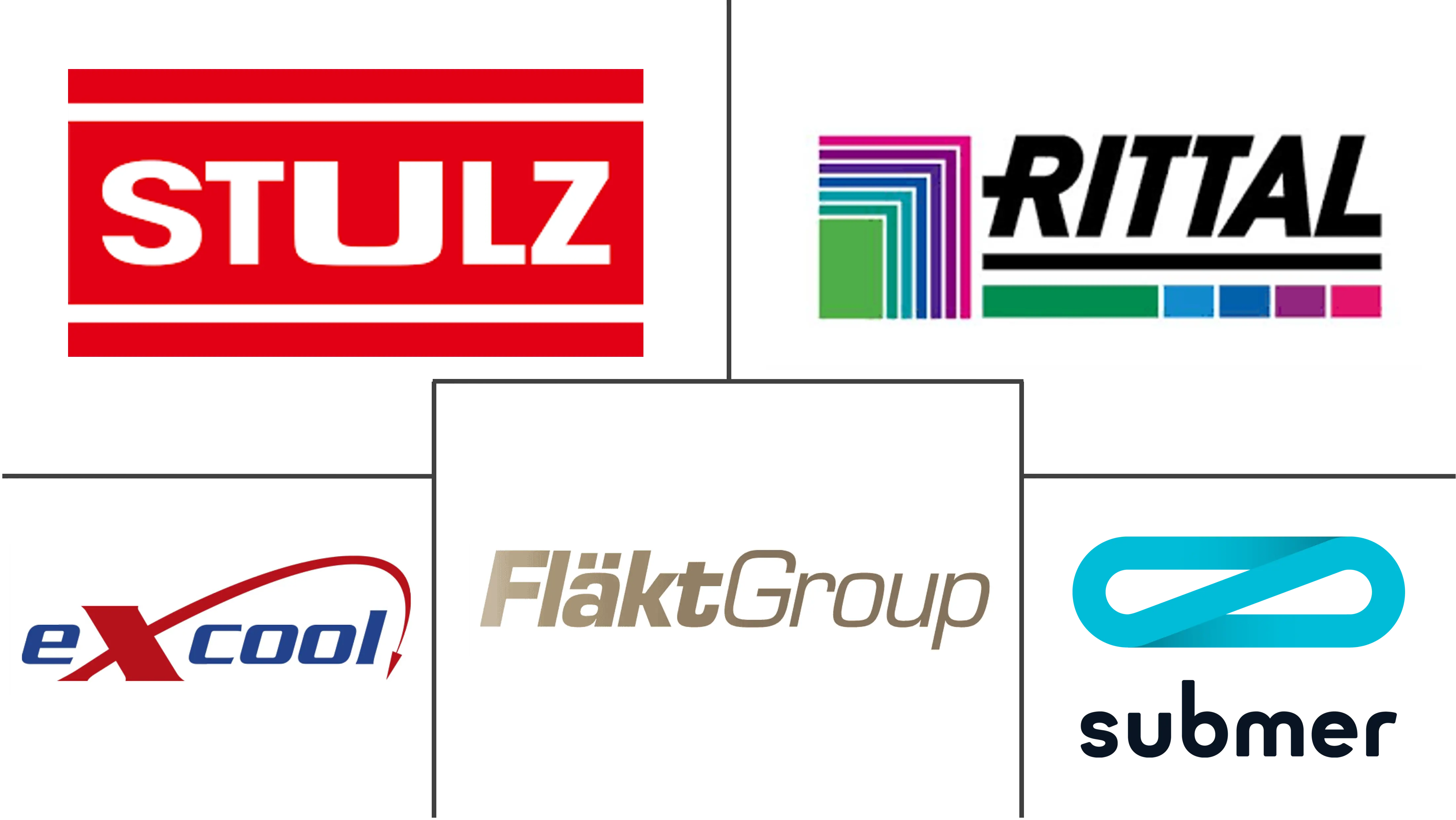Market Size of Sweden Data Center Cooling Industry

| Study Period | 2019 - 2030 |
| Base Year For Estimation | 2023 |
| Forecast Data Period | 2024 - 2030 |
| Historical Data Period | 2019 - 2022 |
| CAGR (2024 - 2030) | 7.40 % |
| Market Concentration | High |
Major Players
*Disclaimer: Major Players sorted in no particular order |
Sweden Data Center Cooling Market Analysis
The Sweden Data Center Cooling Market is expected to register a CAGR of 7.40% during the forecast period.
The Sweden data center cooling market reached a value of USD 124.3 million in the previous year, and it is further projected to register a CAGR of 7.4% during the forecast period.
- As Sweden has a very cold climate, it makes an attractive location for data centers, offsetting the need for major server cooling systems. However, urban data centers are increasingly important as the 'edge' of the network develops. Cooling-as-a-service is one advantage they have over remote sites, leading to major market demand.
- The upcoming IT load capacity of the Sweden data center market is expected to reach around 400 MW by 2029. The country's construction of raised floor area is expected to increase to 1.7 million sq. ft by 2029.
- The country's total number of racks to be installed is expected to reach 87.1K units by 2029. Stockholm is expected to house the maximum number of racks by 2029. There are close to 26 submarine cable systems connecting Sweden, and many are under construction. One such submarine cable that is estimated to start service in 2024 is N0r5ke Viking 2, which stretches over 9,000 km with landing points from Lagunen, Sweden.
Sweden Data Center Cooling Industry Segmentation
Data center cooling is a set of techniques and technologies to maintain optimal operating temperatures in data center environments. Data center cooling is critical as data center facilities house many computer servers and network equipment that generate heat during operation. Efficient cooling systems are used to dissipate this heat and prevent equipment from overheating, ensuring continued reliable operation of the data center. Various methods, such as air conditioning, liquid cooling, and hot/cold aisle containment, are commonly used to control temperature and humidity in data centers.
The Sweden data center cooling market is segmented by cooling technology type (air-based cooling, liquid-based cooling, and evaporative cooling) and end-user (IT & telecommunication, BFSI, government, media & entertainment, and other end-users).
The market sizes and forecasts are provided in terms of value (USD) for all the above segments.
| Cooling Technology | |
| Air-based Cooling | |
| Liquid-based Cooling | |
| Evaporative Cooling |
| End-User | |
| IT & Telecommunication | |
| BFSI | |
| Government | |
| Media & Entertainment | |
| Other End-Users |
Sweden Data Center Cooling Market Size Summary
The Sweden data center cooling market is experiencing significant growth, driven by the country's favorable climate and renewable energy resources. The cold climate reduces the need for extensive cooling systems, making Sweden an attractive location for data centers. However, the rise of urban data centers and the development of edge networks are increasing the demand for advanced cooling solutions, such as cooling-as-a-service. The market is also benefiting from Sweden's low power prices, largely due to hydropower, which attracts telecom companies seeking to reduce their carbon footprint and operational costs. The expansion of mobile networks, particularly with the rollout of 5G, is further fueling investments in data center infrastructure, necessitating efficient cooling technologies to support high-density racks and increased data traffic.
The market is characterized by the adoption of innovative cooling solutions, including liquid cooling and free cooling methods, which are essential for maintaining the reliability of high-density IT systems. Companies like Interxion and Conapto are leveraging seawater and rainwater harvesting to reduce energy and water consumption, respectively. The industry is also witnessing investments from major cloud providers such as Google, Microsoft, and Amazon, who are establishing data centers in Sweden to promote sustainable business practices. Key players in the market, including Submer Technologies, FlaktGroup Holding GmbH, and Excool Ltd., are focusing on expanding their market presence through strategic collaborations and the introduction of environmentally friendly cooling solutions. Recent advancements, such as STULZ's CyberCoolFree Cooling Booster and Daikin's R-32 chillers, highlight the industry's commitment to sustainability and efficiency in data center cooling.
Sweden Data Center Cooling Market Size - Table of Contents
-
1. Market Dynamics
-
1.1 Market Overview
-
1.2 Market Drivers
-
1.2.1 Development of IT Infrastructure in the Country
-
1.2.2 Emergence of Green Data Centers
-
-
1.3 Market Restraints
-
1.3.1 Adaptability Requirements and Power Outages
-
-
1.4 Value Chain / Supply Chain Analysis
-
1.5 Industry Attractiveness - Porter's Five Forces Analysis
-
1.5.1 Threat of New Entrants
-
1.5.2 Bargaining Power of Buyers/Consumers
-
1.5.3 Bargaining Power of Suppliers
-
1.5.4 Threat of Substitute Products
-
1.5.5 Intensity of Competitive Rivalry
-
-
1.6 Assessment of COVID-19 Impact
-
-
2. MARKET SEGMENTATION
-
2.1 Cooling Technology
-
2.1.1 Air-based Cooling
-
2.1.2 Liquid-based Cooling
-
2.1.3 Evaporative Cooling
-
-
2.2 End-User
-
2.2.1 IT & Telecommunication
-
2.2.2 BFSI
-
2.2.3 Government
-
2.2.4 Media & Entertainment
-
2.2.5 Other End-Users
-
-
Sweden Data Center Cooling Market Size FAQs
What is the current Sweden Data Center Cooling Market size?
The Sweden Data Center Cooling Market is projected to register a CAGR of 7.40% during the forecast period (2024-2030)
Who are the key players in Sweden Data Center Cooling Market?
Submer Technologies, FlaktGroup Holding GmbH, Excool Ltd., Stulz GmbH and Rittal GMBH & Co.KG are the major companies operating in the Sweden Data Center Cooling Market.

